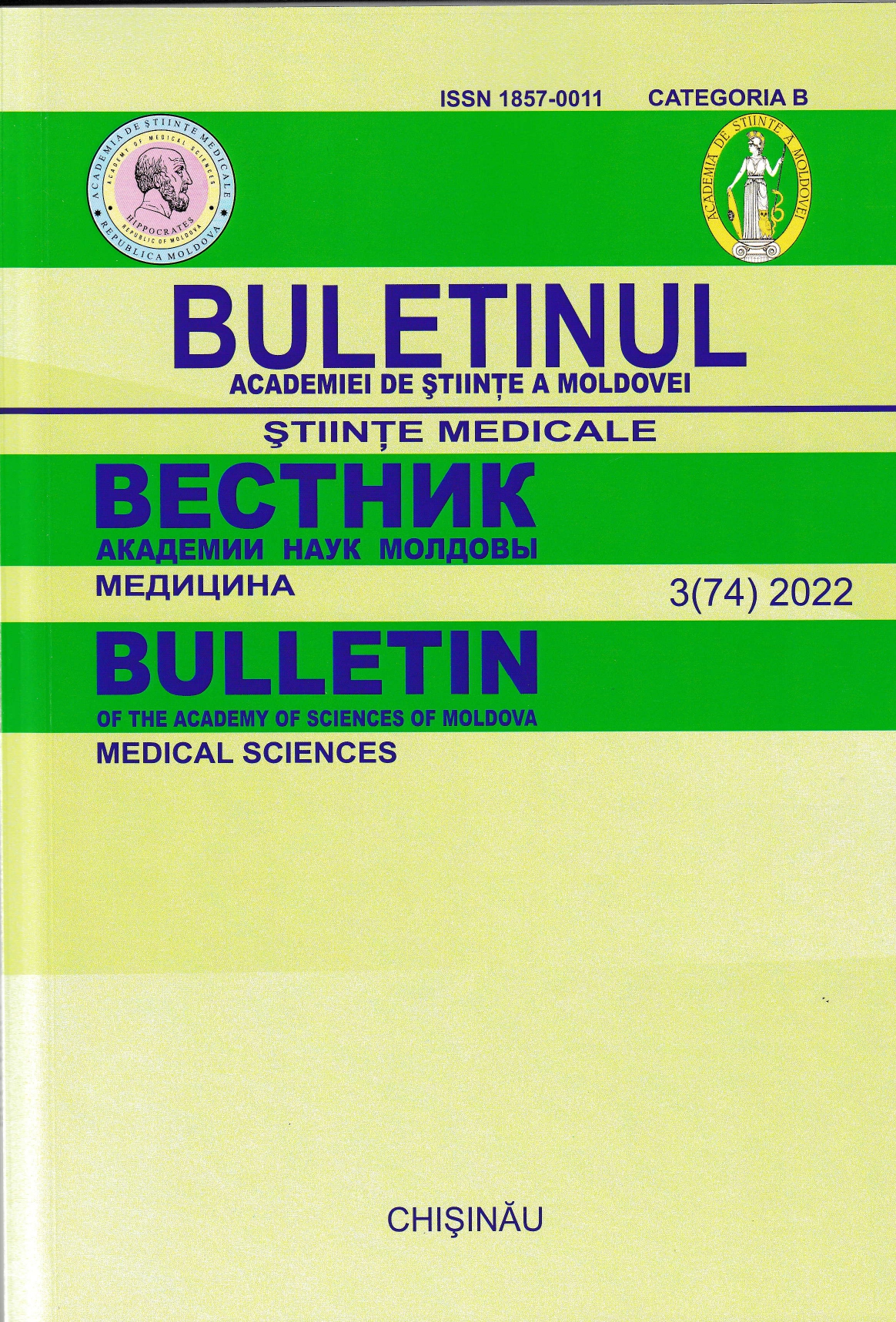Клинико - нейровизуальные особенности институционой когорты молодых пациентов с инсультом.
DOI:
https://doi.org/10.52692/1857-0011.2022.3-74.10Ключевые слова:
инсульт, молодежь, факторы рискаАннотация
Инсульт у молодых людей считается менее распространенным явлением по сравнению с пожилыми людьми, хотя и в последние десятилетия, была замечена отрицательная тенденция и более раннее начало инсульта. Инсульт у молодых людей представляет собой проблему общественного здравоохранения, которая требует профилактического, раннего диагностического и управленческого вмешательства. Целью настоящего исследования является изучение клинических особенностей, факторов риска и других пара-клинических проявлений в молодой популяции, у которой развился инсульт.
Материалы и методы. Разнонаправленный анализ пациентов, поступивших в Институт Неврологии и Нейрохирургии им. Диомида Германа, в возрасте 18–49 лет с подтвержденным инсультом в период с 2019 по 2021 год. Клинические, нейровизуальные и социальные профили пациентов анализировали путем применения описательной статистики.
Результаты: первичный инсульт был у 67,6% анализируемой группы, большинство из которых были ишемическими, в средней мозговой артерии. Факторы риска были дисфункция сердечного ритма у 83%, высокое кровяное давление у 73,2%, ожирение у 19,6% и диабет у 14%. Стоит отметить, что менее половины пациентов проходили лечение и контроль факторов риска. В клинических проявлении преобладают двигательный дефицит 69,6%, нарушения речи – 35,7%, а к менее распространенным проявлениям можно отнести изменение состояния сознания или судороги. Компьютерная томография использовалась у большинства пациентов (87,5 %) с дополнительным магнитно-резонансным резонансом у 36,7% и Доплером у 78,8% для подтверждения и уточнения диагноза. Существует широкий спектр сопутствующих заболеваний, которые включают гематологические расстройства, рак, инфекции и клапанные расстройства, которые способствовали развитию инсульта у молодых людей.
Вывод: хотя в большинстве случаев инсульт у молодых людей имеет характеристики, аналогичные классическим (у пожилых), есть некоторые конкретные тенденции, которые следует оценивать при ведении этой возрастной группы. Профилактика факторов риска важна для всех групп пациентов с инсультом. Конкретные алгоритмы диагностики и лечения помогут клиницистам улучшить результаты, связанные с инсультом, у молодых людей.
Библиографические ссылки
Smajlović D. Strokes in young adults: epidemiology and prevention. Vasc Health Risk Manag. 2015 Feb 24; 11:157-64. doi: 10.2147/VHRM.S53203.
Boot E, Ekker MS, Putaala J, et al Ischaemic stroke in young adults: a global perspective. Journal of Neurology, Neurosurgery & Psychiatry 2020;91:411-417
Singhal AB, Biller J, Elkind MS, Fullerton HJ, Jauch EC, Kittner SJ, Levine DA, Levine SR. Recognition and management of stroke in young adults and adolescents. Neurology. 2013 Sep 17; 81(12):1089-97. doi: 10.1212/WNL.0b013e3182a4a451. Epub 2013 Aug 14. PMID: 23946297; PMCID: PMC3795593.)
George MG, Tong X, Kuklina EV, Labarthe DR. Trends in stroke hospitalizations and associated risk factors among children and young adults, 1995–2008. Ann Neurol 2011; 70:713–721
Carmine Marini, Tommasina Russo, Giorgio Felzani, “Incidence of Stroke in Young Adults: A Review”, Stroke Research and Treatment, vol. 2011, Article ID 535672, 5 pages, 2011. https://doi.org/10.4061/2011/535672.
Khan SU, et al. Clinical and Economic Burden of Stroke Among Young, Midlife, and Older Adults in the United States, 2002-2017. Mayo Clin Proc Innov Qual Outcomes. 2021 Apr 8;5(2):431-441. doi: 10.1016/j. mayocpiqo.2021.01.015. PMID: 33997639; PMCID: PMC8105541
Putaala J, Metso AJ, Metso TM, et al. Analysis of 1008 consecutive patients aged 15 to 49 with first-ever ischemic stroke the Helsinki young stroke registry. Stroke. 2009;40(4):1195–1203
Agustiyaningsih, T., Nur Rohmah, A. I., & Azizah, L. (2022). Factors Affecting the Incidence of Stroke at a Young Age: A Philosophical Perspective. Cold Spring Harbor Laboratory. https://doi.org/10.1101/2022.07.14.22277618
Gillman MW. Primordial prevention of cardiovascular disease. Circulation. 2015 Feb 17;131(7):599-601. doi: 10.1161/CIRCULATIONAHA.115.014849. Epub 2015 Jan 20. PMID: 25605661; PMCID: PMC4349501.
Aigner, A., Grittner, U., Rolfs, A., Norrving, B., Siegerink, B., & Busch, M. A. (2017). Contribution of Established Stroke Risk Factors to the Burden of Stroke in Young Adults. In Stroke (Vol. 48, Issue 7, pp. 1744–1751). Ovid Technologies (Wolters Kluwer Health). https://doi.org/10.1161/strokeaha.117.016599
Griffiths D, Sturm J. Epidemiology and etiology of young stroke. Stroke Res Treat. 2011; 2011:209370. doi: 10.4061/2011/209370. Epub 2011 Jul 18. PMID: 21789269; PMCID: PMC3140048.
Edlow JA, Selim MH. Atypical presentations of acute cerebrovascular syndromes. Lancet Neurol 2011; 10:550–560
Bhat, Dr. Vinayak, et al. Clinical Presentation and Radiological Profile of Patients Presented with Stroke between the Ages of 15-45 Years. International Journal of Advanced Research in Medicine, vol. 4, no. 1, AkiNik Publications, 1 Jan. 2022, pp. 18–20. Crossref, doi:10.22271/27069567.2022.v4.i1a.314
McCarty, J. L., Leung, L. Y., Peterson, R. B., Sitton, C. W., Sarraj, A., Riascos, R. F., & Brinjikji, W. (2019). Ischemic Infarction in Young Adults: A Review for Radiologists. In RadioGraphics (Vol. 39, Issue 6, pp. 1629–1648). Radiological Society of North America (RSNA). https://doi.org/10.1148/rg.2019190033
Miller TR, Shivashankar R, Mossa-Basha M, Gandhi D. Reversible Cerebral Vasoconstriction Syndrome. II. Diagnostic Work-Up, Imaging Evaluation, and Differential Diagnosis. AJNR Am J Neuroradiol 2015; 36(9):1580–1588
Xu W, Zhang X, Chen H, Zhao Z, Zhu M. Prevalence and outcome of young stroke patients with middle cerebral artery stenosis. BMC Neurol. 2021 Mar 4;21(1):99. doi: 10.1186/s12883-021-02125-8. PMID: 33663425; PMCID: PMC7931598
Jayaraj, R. L., Azimullah, S., Beiram, R., Jalal, F. Y., & Rosenberg, G. A. (2019). Neuroinflammation: friend and foe for ischemic stroke. In Journal of Neuroinflammation (Vol. 16, Issue 1). Springer Science and Business Media LLC. https://doi.org/10.1186/s12974-019-1516-2
Bergman, E-M, Henriksson, KM, Åsberg, S, Farahmand, B, Terént, A. National registry-based case–control study: comorbidity and stroke in young adults. Acta Neurol Scand 2015: 131:394–399. 2015 John Wiley & Sons A/S. Published by John Wiley & Sons Ltd..
Загрузки
Опубликован
Лицензия
Copyright (c) 2022 Вестник Академии Наук Молдовы. Медицина

Это произведение доступно по лицензии Creative Commons «Attribution» («Атрибуция») 4.0 Всемирная.



